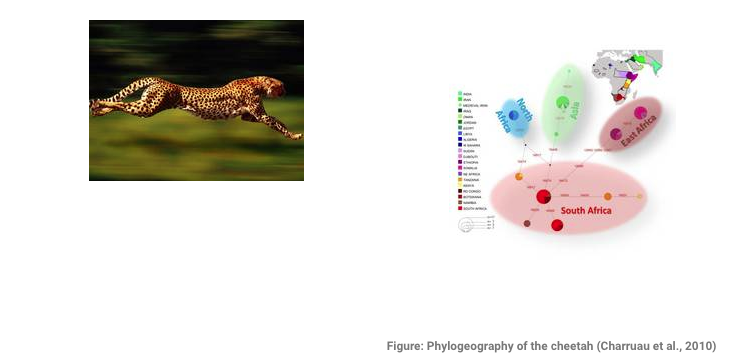[trx_title type=”1″ style=”regular” align=”left” color=”#676362″ top=”inherit” bottom=”inherit” left=”inherit” right=”inherit”][trx_dropcaps style=”2″ top=”inherit” bottom=”inherit” left=”inherit” right=”inherit”]Projets[/trx_dropcaps][/trx_title]
Projects carried out in the core facility of Palaeogenomics and Molecular Taphonomy of the IJM:
Projects are conducted in collaboration with the Palaeogenome group of the Institut Jacques Monod (IJM). Researchers and students from outside laboratories are invited to perform their internships and sabaticcal leaves in this facility in collaboration with the Palaeogenome group.
Apart from the proper projects of Palaeogenome group of the IJM, two projects in collaboration have been or are currently being carried out so far:
1. Phylogeography of the cheetah in collaboration with the “Research Institute of Wildlife Ecology, University of Veterinary Medicine, Vienna, Austria” and the “Institute of Population Genetics, Department of Biomedical Sciences, University of Veterinary Medicine, Vienna, Austria”.
The cheetah (A.jubatus) is a highly endangered species. Its present taxonomic classification has so far been based on socio-geographical criteria without genetic support. In contrast, genetic data are indispensible to design conservation biology strategies. Therefore, we have undertaken a characterization of present and past cheetah populations in Africa and Asia. We have shown that the present assumption of a genetic continuity between African and Asiatic populations is wrong and the proposed strategy of introducing South African cheetah in Asia is questionable.

For this study, a graduate student from the University of Vienna joined the laboratory for three months and performed the research on ancient and historical (museum) specimens in collaboration with the Palaeogenome group.
Charruau, P., Fernandes, C., Orozco-Ter Wengel, P. Peters, J., Hunter, L., Ziaie, H., Jourabchian, A., Jowkar, H., Schaller, G., Ostrowski, S., Vercammen, P., Grange, T., Schlötterer, C., Kotze, A. Geigl, E.-M., Walzer, C., Burger, P.A. Phylogeography, genetic structure and population divergence time of cheetahs in Africa and Asia: evidence for long-term geographic isolation. Mol. Ecol. 20(4):706-24, 2010. Abstract
2. Study of cat domestication in collaboration with the Royal Belgian Institute for Natural Sciences, Brussels, Belgium and the Laboratory of Forensic Genetics and Molecular Archaeology, Center for Archaeological Sciences, Katholieke Universiteit Leuven, Belgium.
The timing and events leading to the domestication of cats are still unclear. So far, only modern cats have been analyzed genetically (Driscoll et al., 2007) indicating that domestication took place in the Near East, probably coincident with agricultural village development in the Fertile Crescent. The association with humans may have been related to the feeding of cats on the rodent pests that developed as a result of the grain storage practices of the first farmers. The data set on which this conclusion is based, however, is incomplete and ancient samples were not analyzed at all. The analysis of ancient material is needed in order to gain insight into the process. Therefore, we undertook a study of archaeological bone remains from Egypt and Turkey, complemented by mummy samples from ancient Egypt, where domestication was traditionally believed to have happened by the Middle Kingdom (Malek, 1993).
This study was started by a researcher from the University of Leuven, Belgium, who performed a 6 month internship in the laboratory. The study is still underway and will be extended to more samples from Europe, Southwest Asia and Northern Africa making a second research period of the researcher from Leuven University necessary.
3. Study of ancient human parasites. In collaboration with the University of Besançon, France, a PhD student will perform the analysis of parasites such as Enterobius vermicularis, Taenia sp. and Ascaris lumbricoides preserved in the sediments of selected archaeological sites. The taxonomic identification of the parasite species will help to gain insight into the presence of animals, parasite load, demographic pressure, nutritional habits and into the contemporaneous palaeoenvironment.

